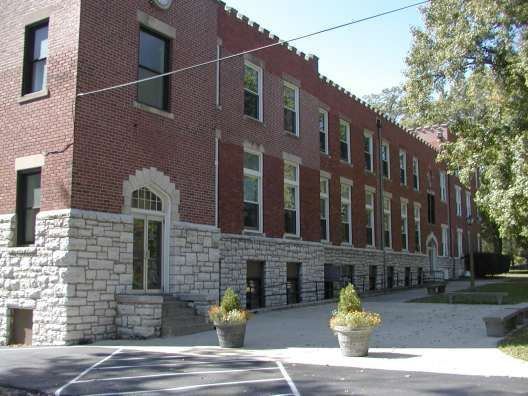 | ||
Western military academy graduation 1966 silent
Western Military Academy was a private military preparatory school located in Alton, Illinois, in the United States. Founded in 1879, Western Military Academy closed in 1971. The campus is located in the National Register of Historic Places District (ID.78001167). The school motto was Mens Sana in Corpore Sano ("A sound mind in a sound body").
Contents
- Western military academy graduation 1966 silent
- Western military academy
- Early years
- 19001940
- The world wars
- 19401970
- Cultural entertainment
- Athletics
- School closing
- Notable alumni
- References
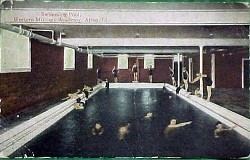
Western military academy
Early years
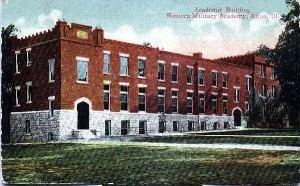
In 1879, Edward Wyman, an 1835 Amherst College graduate, opened a boarding school for boys in what was then Upper Alton, Illinois. Wyman had previously been an esteemed educator in the St. Louis public schools. Upper Alton's Wyman Institute was Edward Wyman's final contribution to the field of education. A school circular stated that Wyman believed the west needed a "boarding school for the proper education of young men." In 1887 Wyman hired Albert M. Jackson to be a member of the staff. Jackson was an 1884 Princeton graduate and had just completed two years of teaching mathematics and Latin at Blair Academy in New Jersey. Upon Wyman's death in 1888, ownership of the school passed to Col. Willis Brown and Albert M. Jackson was made the principal. It was during this time that the school changed its name to Western Military Academy and introduced military training. After eight years at the helm, Col. Brown chose to retire. In 1896 Albert M. Jackson and the academy's financial officer, George D. Eaton purchased Western Military Academy. The Jackson family would retain ownership of the school until it closed its doors in 1971.
1900–1940
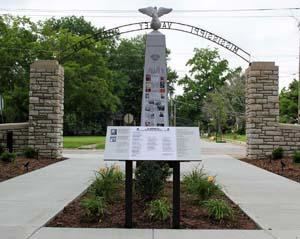
In 1900 the academy had an enrollment of 100 cadets. Early in the century, Western was designated an Honor Military School by the United States War Department. By 1920 WMA had been listed in "Distinguished Colleges and Military Schools". That standing granted a school the right to one appointment, without examination, to both the Regular Army and to West Point. A major crisis was confronted in February 1903. Fire destroyed the school administration building and the primary barracks. The academy was closed while the ownership planned to rebuild in time to open in the fall of 1903. The opening of Western Military Academy in September, as planned, saw a new administration building and two barracks completed with an enrollment of 132 students. A third barracks was completed during the academic year. By 1924 two additional barracks had been added, giving the campus the look it would have until it closed. The first edition of the Western yearbook was published that year, titled The Recall. Enrollment grew as the facilities were added and Western enjoyed a full complement of over 300 cadets from 1912 through the 1920s. The reputation of the academy spread as its graduates became successful. William Paley, a 1918 graduate, went on to become the Chairman of the Board for Columbia Broadcasting System. Paley would recall his time at Western Military Academy as a "turning point of my life."
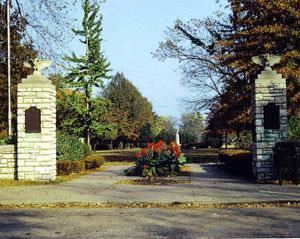
The onset of the Great Depression had a profound effect on the enrollment of Western. The 1930s found the academy at half capacity on a regular basis. The school was able to maintain quality programs as a list of its graduates will attest. Among those graduating from the academy during the 1930s were some of World War II's most decorated pilots. Edward O'Hare, a 1932 WMA alumni, was awarded the Medal of Honor for his heroism in naval air combat before dying in action in 1943. O'Hare International Airport in Chicago is named in his honor. One year after O'Hare graduated, Paul Tibbets became a 1933 alumnus of Western. He was selected to lead what many believe was the most important mission in the history of military aviation. On August 6, 1945 he piloted his plane, the Enola Gay, to drop the first atomic bomb on Hiroshima, Japan. The end of the 1930s and the concern over the war in Europe would change Western Military Academy's enrollment concerns.
The world wars
Western Military Academy kept detailed service records of her graduates during the First and Second World Wars. The most definitive of the World War I records, as highlighted in History of Western Military Academy, Alton, Il 1879–1971 by Robert Scott, shows that of the 402 WMA graduates after 1909, 295 or 73% served in the military during the conflict. Four graduates died in the service and others were listed as "wounded" or "lightly gassed."
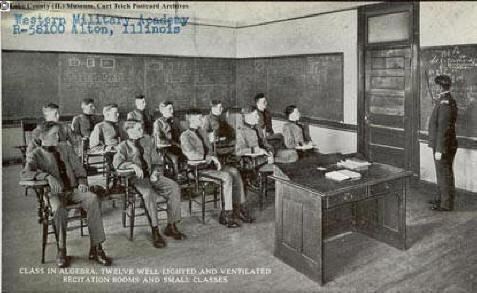
World War II records show that over 1,000 alumni served. That is an especially notable number for a school that had, at the time, only 2,000 graduates. Over forty were killed in action. Brig. General A. Owen Seaman, WMA 1897, was a member of the earliest known class to serve in World War II. A partial list of the decorations awarded to WMA graduates in the Second World War include, 1 Medal of Honor, 4 Distinguished Service Crosses, 2 Navy Crosses, 4 Legion of Merit medals, 23 Silver Stars and 15 Distinguished Flying Crosses. The school's records on the service of her graduates in the Korean and Vietnam wars are incomplete. The stone front gate on the Western campus is named the Memorial Gate. It honors those alumni who died in the service of their country.
1940–1970
By the 1940s the war in Europe and the improving economic situation in the United States would find Western again at capacity enrollment. Colonel R.L. Jackson (WMA'06) had succeeded his father as superintendent in 1919. He had guided the school through the difficulties of the 1930s and would continue to hold the post into the 1950s. Western would have a waiting list of applicants from the 1940s through the 1960s. The academy could and did attract the best students. Part of the appeal of Western Military Academy was the quality of the academic and military staff. The Military Department was regularly led by graduates of the United States Military Academy. Several members of that department would have a record of distinguished service in the World War II, Korea and Vietnam. Academically, Western boasted a staff with graduates from the most exclusive colleges and universities. Colonel R.L. Jackson, like his father, was a Princeton graduate and had continued his education at Harvard. The 1940 school annual, The Recall, listed instructors who had attended Harvard, Colgate, Yale, Dartmouth, Northwestern, University of Grenoble-France, Columbia, Washington University and Albion College Conservatory. During the thirty-year span from 1940 to the beginning of 1970 Western's enrollment remained in the 300 to 325 range. The academic and military areas of cadet life were supplemented by extensive extra-curricular opportunities.
Cultural entertainment
In a WMA circular printed early in the 1900s, the administration defined their thinking on the topic of entertainment. "Having found by long experience that amusements, indulged in to a reasonable extent, are helpful rather than otherwise, to both the deportment and progress of the cadets, the authorities of the Academy arrange each year a series of receptions, musical and literary entertainments and excursions, so distributed as to relieve somewhat the monotony of school life, and so conducted as to accustom the cadets to the usages of good society." It was a policy the school maintained until it closed.
The prestige of the academy helped attract several notable guests to be part of this program. National Baseball Hall of Fame baseball players Rogers Hornsby, Hank Greenberg and Dizzy Dean talked baseball with the students. Boxer Jack Dempsey gave a speech to the Corps. Bandleader Tommy Dorsey and crooner Frank Sinatra performed at Western as did comic Joe E. Brown. Amelia Earhart and Medal of Honor recipient General Jonathan Mayhew Wainwright IV were among the other guests who spoke at WMA. Several Western alumni would also return to the campus and share their experiences with the cadets.
Athletics
During Western Military Academy's 92 years, athletics were an important part of the cadets environment. A wide variety of sports gave every student the opportunity to participate. Several levels of teams were offered in most sports which included football, cross-country, basketball, wrestling, soccer, swimming, a rifle team, baseball, track, golf and tennis. Western had a golf course designed by prolific golf designer Tom Bendelow on campus in the early 1900s. Other sports offered at times during the schools existence included interscholastic bowling, fencing and an equestrian team.
In the 1930s a WMA catalog labeled football "The King of Sports" at the academy. The school fielded four different teams offering boys of all sizes the chance to play. For most of the school's history well over half the Corps played on a football team. The St. Louis Globe Democrat reported that in 1895 WMA played Smith Academy in the first high school football game ever played in the St. Louis. In 1904 Western began a football competition with Alton High School. The annual Thanksgiving Day game, pitting the cadets against the public school team, became "the biggest event on the Alton sports calendar", according to the Alton Evening Telegraph. Thousands would set aside their Thanksgiving afternoon to attend the game. The rivalry was discontinued in 1952.
School closing
By the late 1960s, rising costs and inflation meant the academy would face economic hardships as it moved into the 1970s. The anti-military sentiment caused by the Vietnam War was a major factor in Western's declining enrollment, and had a drastic impact in just a few years. In 1967–68 the school's barracks were filled to capacity, with an enrollment of 325 cadets; three years later, in the 1970-1971 school year, enrollment had dropped by more than half to 154, as shown in the 1971 yearbook, The Recall. In June 1971 the Western Military Academy held its 92nd and final commencement ceremony, and afterwards the school was closed.
